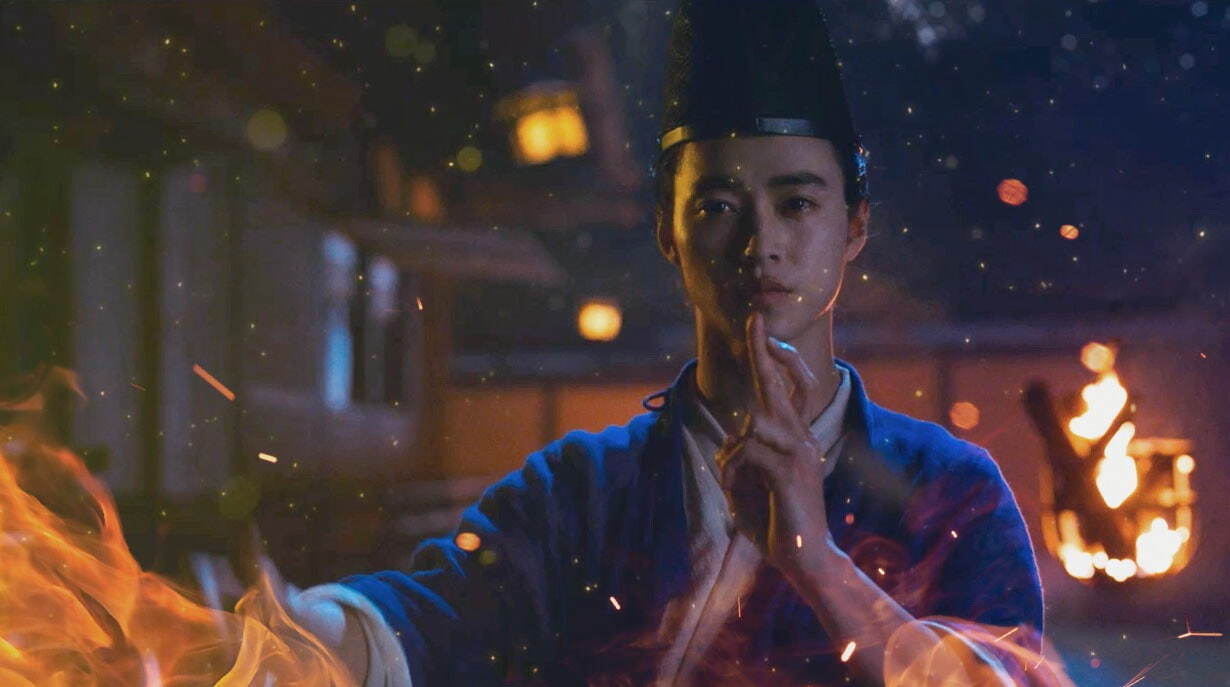Due to Sigmund Freud’s work, the notion of the unconscious has attained a firm place within the collective consciousness and the world of pop culture. Given the ongoing influence of Freud’s thinking on the societal fabric, it is not surprising that artists around the world have wielded psychoanalytic knowledge to creatively explore the past and give an entertaining spin to certain historical figures.
One can argue that Baku Yumemakura relied on the popularized ideas of Freud to fantastically dramatize the life of the historical figure of Abe No Seimei, Japan’s most powerful Onmyoji (yin-yang master). Coinciding with his 1,100th anniversary, Shimako Sato, with full cooperation of novel series’ writer, brings the birth of the legend to the silver screen.
During the Heinan period, the emperor, who stood at the apex of the governmental body, used the services of a personal Onmyoji to decide policies through divination, astrology, and other spiritual practices. With the current position vacant, nearly everyone at the Onmyoryo Bureau of Taoist Geomancy – apprentices, artificers, masters, doctors, as well as the grandmaster – is eager to use this chance to rise the hierarchal ladder.
The talented Abe no Seimei (Kento Yamazaki), however, is not interested in rising the ranks – he is lazy and unambitious. Yet, he is not without desire. While Seimei refuses to inscribe himself into the social and hierarchical dynamic that structures the Heian governmental field and accept the Other’s desire to become the emperor’s Onmyoji as his own, his acts and signifiers are guided by his desire to confront his parents’ murderer. His presence within this hierarchal system is, as becomes evident, determined by the need to repay Kamo no Tadayuki (Jun Kunimura), the man who adopted and saved his life, and by the knowledge the field of Yin-Yang mastery offers him to chase his desire.
One day, vice-minister Lord Minamoto no Hiromasa (Shota Sometani) approaches Abe no Seimei to ask him to investigate a supernatural phenomenon occurring at the palace princess Yoshiko (Nao), a former Ise shrine Maiden. Not that much later, an artificer called Yasuie is murdered at his own home and Abe no Seimei becomes surprisingly, the prime suspect.
Given the lack of knowledge in contemporary audiences about Taoist Geomancy, it is not surprising that the opening of Yin Yang Master 0 is heave on exposition. Yet, despite the overflow of information, Sato’s opening sequence succeeds in pulling the spectator into the story not simply by dazzling him with impressive imagery of Heian Japan, but by finding an effective balance between telling – the voice-over sketching the narrative’s setting – and showing – the imagery that brings the sketched-out setting to life.
The central mechanic that animates the narrative’s development is the dramatized device of deception through suggestion, i.e. the manipulation of a subject’s conscious perception by feeding him suggestive signifiers. The impact of such signifier does not merely determine the perceived reality of the subject subjected to these words, but also causes the bubbling up of bodily and emotional reactions.
Yin Yang Master 0 is thus not only about people believing in what they cannot see, like demons and spirits, but also about being duped by seeing what one is led to believe through the seductive signifier. Despite the fantastical nature of this suggestion, Sato nevertheless corroborates the well-known psychoanalytic fact that that signifiers or language colour our perception and determine the colour and quality of our perceived reality.
The device of suggestion, which causes the explosion of fantastical imagery and determines the many twists within Yin Yang Master 0, offers the visual and narrative frame for Sato to explore the destructive quality of greed, a greed fed by the societal demand to radically assume the Other’s desire and inscribe oneself in its discourse. Or, to put it differently, Sato explores how the desire to rise in the social ranks of a very rigid and competitive society will be exploited by those who hold power to devise devious ploys to generate feelings of paranoia and entice violent conflicts among those who vie for some power. Sato, moreover, utilizes the dynamic between Minamoto no Hiromasa and princess Yoshiko to echo how an archaic patriarchal societal system demands the erasure of female subjectivity and the repression of male desire.
So, how does Yin Yang Master Zero bring the psychoanalytic unconscious alive? In short, visually. Within the narrative, the unconscious is a dream-like visual space that can be entered by multiple subjects and manipulated by their signifiers. The unconscious is thus not only introduced as a Freudian entity where our ‘repressed’ desires (greed, … etc.) run wild, but also as a Jungian thing that connects us all. Only the idea of a collective unconscious can explain why, in Yin Yang Master 0, different subjects materially share the visualized space of what escapes the subjective and social consciousness.
The composition of Yin Yang Master 0 is, not surprisingly, full of dynamism. This reliance on dynamism does not merely give the visual fabric an enticing and engaging flow, but allows Sato to further emphasize the dream-like quality of the space called the unconscious.
The dynamism that lingers within conversational sequences blossoms completely in the action-sequences (Music-note 1). The dynamism, interacting with the dramatic and tensive musical score, gives these visual moments the power to engage the spectator. Yet, the true joy of these moments lies in Sato’s skill to let the more fantastical action-moves shine and thrill the spectator without deflating the tension generated by the dynamic flow and the dramatic rhythm of the music.
The rich and vibrant visual effects fit well within the idea the dream-like quality of the unconscious space. Sato does not aim to craft a ‘reality’ with these effects – a visual space that dupes us into thinking its real, but to visualize the fantastical, that what can only be produced in dreams by the unconscious and its processes of metaphor and metonymy.
Yin Yang Master 0 delivers a fantastical visual experience like no other. While such reliance on visual effects could have led to a narrative with all flash but no substance, Sato’s fantastical imagery is subjected to the demands of the narrative. The visual effects serve the unfolding of the narrative and the many twists that guide its path.
Notes
Music-note 1: The flow of the visual fabric is elegantly supported by the thoughtful use of musical accompaniment and sounds.





